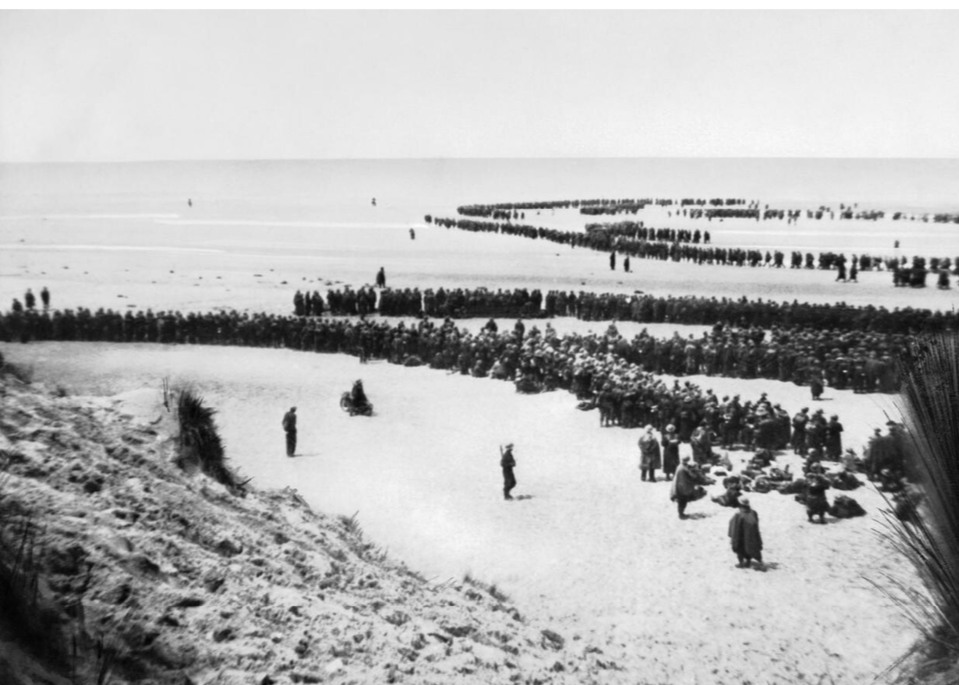Escape from Dunkirk, May 1940 Alan Payne January 2018
Several Box people were directly caught up in the events of the Dunkirk evacuation and most families followed the news of events gathered around their wireless sets. When France fell to the German invaders in May 1940 the BEF (British Expeditionary Forces) were left isolated and likely to be captured, the whole root and core and brain of the British Army according to Churchill.
Between 27 May and 4 June 330,000 troops were evacuated to England sailing in an assortment of 860 boats, naval ships, barges, tugs and ferries. On 4 June Churchill depicted the rescue as a miracle of deliverance and gave his famous We shall fight on the beaches speech. The author JB Priestly described it as Glory snatched out of defeat. And we still talk about the Dunkirk Spirit.
Box's Survivors
On 16 June the local newspaper echoed Churchill's sentiment with a heading Bill Cook Returns to Box from Dunkirk.[1] Guardsman Bill Cook lived at Ellesmere, The Lycetts, with his wife and mother. Bill brought with him a beautiful French gown and dress for his wife, which he had found abandoned in an attaché case on Dunkirk beach. He had lacked clothing and arrived dressed in assorted apparel, lady's clothing, civilian trousers and a French officer's jacket.
An early returnee was Sapper J Orritt of the Royal Engineers who lived at Fair View with his wife, small daughter and sons. The third arrival was Lance Corporal MJ Gape, young son of Box's policeman Joseph Gape who lived at Fairmead View after making a miraculous escape from Dunkirk.
The evacuated servicemen were given a few days' leave and many stayed in the Bath area on their way home. They were given a meal, a warm welcome and overnight stay in central accommodation. The steward of the central accommodation and his wife gave up their beds overnight for the servicemen, a incredible gesture considering that they allowed Corsham workers on night shifts to occupy them during the day.[2] The cheerfulness of these boys, most of whom were between 22 and 23 years of age, was an inspiring example. They were only anxious to be "at it again".
Realising how close their escape had been a number of local servicemen hastily married on their brief leave after Dunkirk, in case they should not be so lucky next time.[3]
Between 27 May and 4 June 330,000 troops were evacuated to England sailing in an assortment of 860 boats, naval ships, barges, tugs and ferries. On 4 June Churchill depicted the rescue as a miracle of deliverance and gave his famous We shall fight on the beaches speech. The author JB Priestly described it as Glory snatched out of defeat. And we still talk about the Dunkirk Spirit.
Box's Survivors
On 16 June the local newspaper echoed Churchill's sentiment with a heading Bill Cook Returns to Box from Dunkirk.[1] Guardsman Bill Cook lived at Ellesmere, The Lycetts, with his wife and mother. Bill brought with him a beautiful French gown and dress for his wife, which he had found abandoned in an attaché case on Dunkirk beach. He had lacked clothing and arrived dressed in assorted apparel, lady's clothing, civilian trousers and a French officer's jacket.
An early returnee was Sapper J Orritt of the Royal Engineers who lived at Fair View with his wife, small daughter and sons. The third arrival was Lance Corporal MJ Gape, young son of Box's policeman Joseph Gape who lived at Fairmead View after making a miraculous escape from Dunkirk.
The evacuated servicemen were given a few days' leave and many stayed in the Bath area on their way home. They were given a meal, a warm welcome and overnight stay in central accommodation. The steward of the central accommodation and his wife gave up their beds overnight for the servicemen, a incredible gesture considering that they allowed Corsham workers on night shifts to occupy them during the day.[2] The cheerfulness of these boys, most of whom were between 22 and 23 years of age, was an inspiring example. They were only anxious to be "at it again".
Realising how close their escape had been a number of local servicemen hastily married on their brief leave after Dunkirk, in case they should not be so lucky next time.[3]
References
[1] Bath Weekly Chronicle and Herald, 15 June 1940
[2] Bath Weekly Chronicle and Herald, 15 June 1940
[3] Bath Weekly Chronicle and Herald, 15 June 1940
[1] Bath Weekly Chronicle and Herald, 15 June 1940
[2] Bath Weekly Chronicle and Herald, 15 June 1940
[3] Bath Weekly Chronicle and Herald, 15 June 1940
